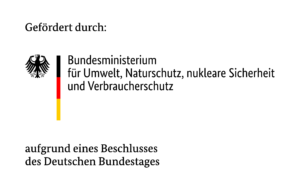Wild bee populations are declining
The decline of insects and especially pollinator insects such as wild bees has not stopped in Lusatia. Habitat loss (e.g. small structures), the expansion of monocultures, large-scale farming, and the use of pesticides in agriculture and private gardens have also made life difficult for wild bees in Lusatia. Their habitat is becoming increasingly monotonous and scarce, which greatly reduces the available nesting opportunities and food supply. Yet wild bees make a major contribution to the pollination of many flowering plants – including agricultural crops such as rape, berries and fruit.
A network of habitat islands for wild bees
For the recovery of wild bees to succeed, a network of suitable habitats is needed, which may well be small-scale, and, in addition to breeding opportunities, should also provide food sources and opportunities for overwintering and be free of pesticides. The villages distributed throughout the project area, with their hitherto unused residual areas and some redesigned garden corners, should form a network that ensures the survival of wild bees and other animal species.
Arousing interest in wild bees and their habitats
With events such as lectures, hands-on activities and identification courses, we want to arouse interest in the topic. We teach interested citizens to distinguish wild bees from other insects and to recognise the most important, regionally occurring species and species groups. At the same time, essential knowledge about the ecology of the species, the required habitats, the endangerment and the protection of wild bees is imparted.
Creating habitat islands for wild bees
An important goal of the project is to work with citizens to restore habitats for wild bees, for example in villages and village margins. To this end, we are working with various cooperation partners to build bee castles, which are both nesting sites and, with their planting, also a source of food, and to create flowering stripes. The project area includes the two nature parks “Niederlausitzer Landrücken” and “Niederlausitzer Heidelandschaft” and the connecting corridor between them. An entire network of “bee rescue islands” is to be created here.
Data as a basis for further findings
There are still many gaps in our knowledge about the distribution of wild bee species and their habitats in the region. We want to close these gaps with the help of citizens (citizen science). We are developing an app that can be used to identify wild bees and map their habitats.

Partner
Heinz Sielmann Stiftung
Förderverein des Naturparkes Niederlausitzer Heidelandschaft e. V. und Kerngehäuse e. V.
Project Funding
Gefördert vom Bundesministerium für Umwelt, Naturschutz, nukleare Sicherheit und Verbraucherschutz (BMUV) aufgrund eines Beschlusses des Deutschen Bundestages

FKZ: 67KMN011
Project management agency: ZUG
